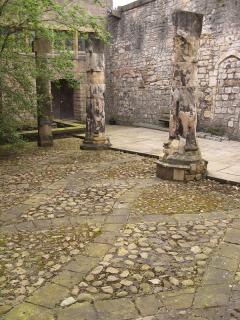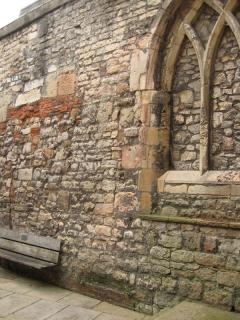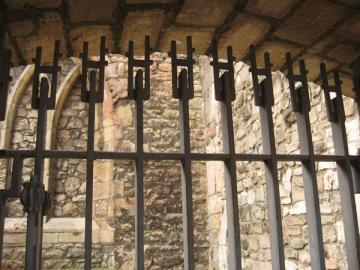This ‘garden of rest’ in the centre of town is perhaps one of those overlooked places we walk past often but don’t really look at.
It’s public and private simultaneously. We can look into it from Coney Street, through an archway guarded by a railing. It’s a guarded garden. There’s another smaller archway to the right, also gated, but clearly with the potential to open. It’s always been locked when I’ve been passing.
St Martin’s on Coney Street was bombed and partially burned out in the ‘Baedeker’ raid of 1942. It had to reinvent itself in a more honest way. It might have evolved through the religious changes of the centuries in an organic kind of fashion, as all these medieval churches did, but a bomb through the roof clears out all of that.
By the late 20th century there wasn’t as much need for churches in the city centre. There wasn’t a large homeless congregation in need of a roof to worship under. St Helen’s is just around the corner, and St Michael’s up the road on Spurriergate. So only part of the church was re-roofed, and the rest was left open to the sky, as this ‘garden of rest’. Architectural fragments from the old church remain, some apparently reset in new positions. There’s a modern memorial, with stylish lettering, visible only from a distance, through the railings.
As with the restored interior of the remaining part of the church, there’s clearly been a great attention to detail by the architect, George Pace. There are many textures in stone and cobble and brick, and fragments of headstone incorporated in curving patterns of paving. Broken columns in the centre of the space, no longer supporting a roof, remind us of the bombing.
Gardens of rest, I always thought, were for us to rest in, alongside the permanently ‘resting’ who have passed away. I’m not sure whether this one was intended to be open to the public. It may have been open in the past – I can’t recall. There are benches, but as far as I can tell no one sits on them.
If they did, the place would no doubt end up covered in litter, so perhaps best to keep it as it is: open to the sky, but closed to passers-by.
Links
Roof bosses from the medieval church, removed in the 19th century, are on display at the Yorkshire Museum: Carved and woven, museum treasures
I wrote about the church many years ago, see the page on St Martin’s from 2007
There’s more information on the church and its history on www.stmartinsyork.org.uk








Thank you for adding a comment. Please note that comments are moderated, but should appear within 24 hours.